Speaker
Description
Understanding the connection between the properties of BHs and their progenitors is interesting in many branches of astrophysics. Traditional methods such as detection through X-ray, radio, or gravitational-wave emission are sensitive towards a small subset of all BH binaries expected to form in nature. In my talk I will explore the exciting possibilities for detecting BHs in detached binary systems with luminous companions (LCs) via astrometric and photometric measurements. We create highly realistic models of BH-LC binaries expected to be there at present in the Milky Way (MW) using the binary population synthesis code COSMIC for two adopted supernovae models. Taking into account Gaia's astrometric precision, spectroscopic resolution, and interstellar extinction and reddening, we find that Gaia in its 10 year mission should detect around 30-300 BH candidates of which 10-100 will have clear mass constraints. These potentially detectable BHs constitute a set complementary to those detected by other traditional methods. Furthermore, since the LC's properties, such as age and metallicity, can be constrained relatively easily, and it is expected that the BH's progenitor must have had the same zero-age properties as the LC, if detected in large numbers as our models suggest, for the first time, we will be able to constrain the highly uncertain map connecting BH properties with those of their progenitors.

